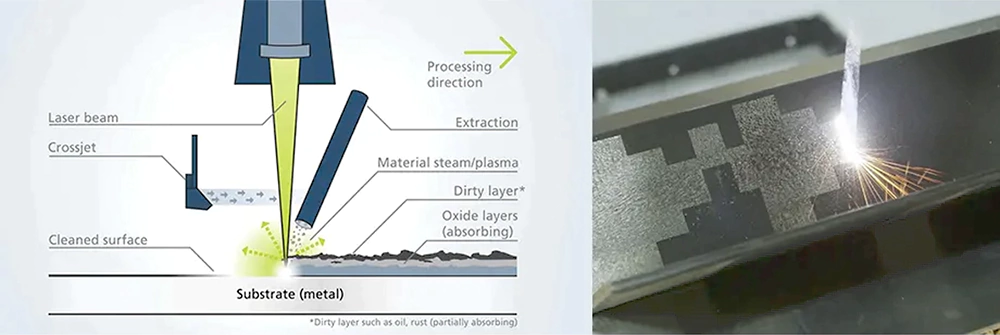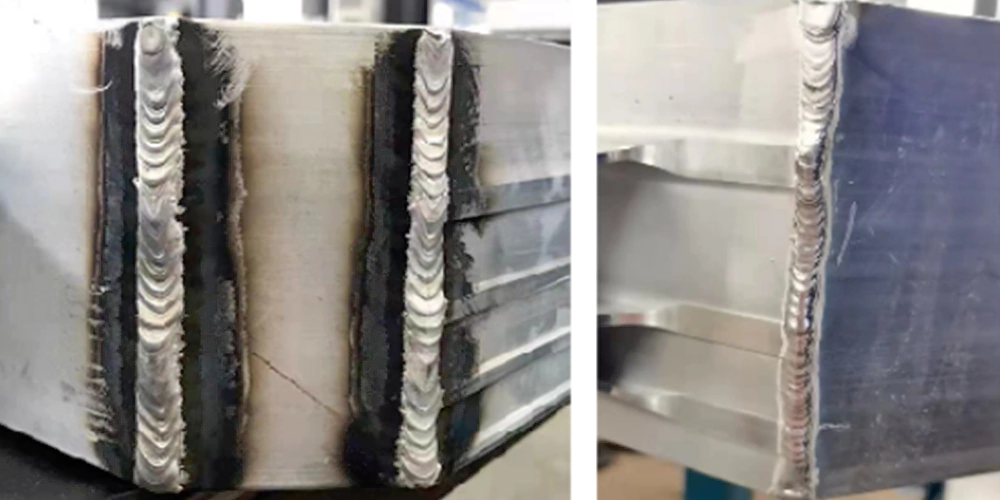The principle of laser cleaning is to utilize the characteristics of laser beam with large energy density, controllable direction and strong convergence ability. The laser interacts with contaminants such as oil stains, rust spots, dust residue, coatings, oxide layers or film layers attached to the workpiece base, and is separated from the workpiece base in the form of instantaneous thermal expansion, melting, gas volatilization, etc. The entire laser cleaning process is complicated and can be roughly divided into laser vaporization decomposition, laser dissection, thermal expansion of contaminant particles, substrate surface vibration and contaminant detachment. Currently, there are laser ablation cleaning methods, liquid film-assisted laser cleaning methods, and laser shock wave cleaning methods, which can stably and effectively clean various regular substrate surfaces, including metals, alloys, glass, and various composite materials.

|
Compare items |
Laser cleaning |
Chemical cleaning |
Mechanical grinding |
|
Cleaning method |
Non-contact laser |
Contact type chemical cleaner |
Contact type mechanical, sandpaper |
|
Damage |
No damage |
Damaged |
Damaged |
|
Cleaning efficiency |
High efficiency |
Ineffective |
Ineffective |
|
Consumables |
Only electricity required |
Chemical cleaning agents |
Sandpaper, grinding wheel, etc. |
|
Cleaning effect |
High cleanliness |
Average, uneven |
Average, uneven |
|
Cleaning precision |
Accurate and controllable, high accuracy |
Uncontrollable, poor accuracy |
Uncontrollable, poor accuracy |
|
Pollute |
No pollution |
Polluting the environment |
Polluting the environment |
|
Operation difficulty |
Simple operation and easy integration into automation |
The process is complex and high operational requirements, requiring anti-pollution measures. |
Time-consuming and labor-intensive, requiring anti-pollution measures |
|
Cost |
High initial investment, no consumables, and low maintenance costs |
Low initial investment and extremely high consumable costs |
Low initial investment, high consumable and labor costs |
Application of laser cleaning in lithium-ion battery manufacturing
At present, laser cleaning has become the main means of battery surface treatment and is widely used in the three main power battery production processes of electrode manufacturing, battery cell manufacturing and battery assembly. By using lasers, cleaning heads, control software, and computer integrated control, the level of battery manufacturing technology is greatly improved.
Electrode laser cleaning
When coating electrode materials on positive and negative current collectors, the metal foil needs to be cleaned. The common positive current collector is aluminum foil, and the negative current collector is copper foil. In order to ensure the stability of the current collector inside the battery, the purity of both is required to be above 98%.
Traditional wet ethanol cleaning can easily cause damage to other components of lithium batteries. Using laser to clean metal foil can not only improve the efficiency of the cleaning process but also save cleaning resources. In addition, the establishment of real-time monitoring of cleaning process data and quantitative determination of cleaning results can effectively improve the consistency of electrode batch production.
Laser cleaning before battery welding
In recent years, laser welding has become a standard feature of power battery production lines and is widely used in the welding of power battery tabs, sealing nails, busbars, battery modules, etc. A clean, uniform surface is an essential prerequisite for successful and durable welding and bonding. Therefore, before welding, surface treatment of each welding part to remove contaminants at the weld joint can effectively improve welding quality and reduce costs.
Terminal cleaning comparison
Laser cleaning is used in the cleaning process of sealing nails, adapter sheets, terminals, single-cell blue film, single-cell silica gel, and single-cell coating. Effectively remove dirt, dust, etc. From each end face to prepare for battery welding in advance and reduce welding defective products.

Laser cleaning during battery assembly
In order to prevent safety accidents in lithium batteries, lithium battery cells are often glued to the outside to provide insulation, prevent short circuits, protect circuits, and prevent scratches.
Cleaning the oxide layer of battery tray welds
Laser cleaning is performed on the cmt welds of the battery pack tray, the electrophoretic paint of the upper cover of the battery pack, the oxide layer of the sealant track of the battery pack box, and the oxide layer of the protective bottom plate before welding. Improve the adhesion of glue or glue, and will not produce harmful pollutants after cleaning.

Advantages of laser cleaning
Environmental advantages
Laser cleaning is a "green" cleaning method. There is no need to use any chemicals or cleaning fluids. The cleaned waste materials are basically solid powder. They are small in size, easy to store, recyclable, have no photochemical reaction, and will not produce pollution. It can easily solve the environmental pollution problem caused by chemical cleaning. Often an exhaust fan can solve the problem of waste generated by cleaning.
Effect advantage
Traditional cleaning methods are often contact cleaning, which exerts mechanical force on the surface of the object being cleaned and damages the surface of the object. Or the cleaning medium adheres to the surface of the object to be cleaned and cannot be removed, causing secondary pollution. The non-abrasive, non-contact, and non-thermal effects of laser cleaning will not damage the substrate.
Controllable advantages
Laser can be transmitted through optical fiber and cooperated with robot hands and robots to facilitate long-distance operation. It can clean parts that are difficult to reach with traditional methods, which can ensure the safety of personnel when used in some dangerous places.
Advantages of convenience
Laser cleaning can remove various types of contaminants from the surface of various materials, achieving a level of cleanliness that conventional cleaning cannot achieve. It can also selectively clean contaminants on the material surface without damaging the material surface.
Cost advantage
Laser cleaning is fast, efficient and saves time. Although the initial one-time investment in purchasing a laser cleaning system is high, the cleaning system can be used stably for a long time, has low operating costs, and more importantly, can easily realize automated operations.